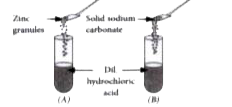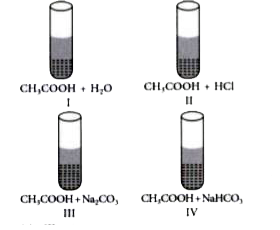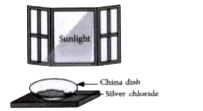Complete Solutions to MCQ of chapter FOOTSTEPS TOWARDS (NEET) of Class 10 book with complete answers and questions
| Class 10 | CHEMISTRY |
| Chapter | FOOTSTEPS TOWARDS (NEET) |
| MTG IIT JEE FOUNDATION | MCQ |
| Number Of Questions | 45 |
| Academic Year | 2023-24 |
The incorrect statement about metals is
View SolutionWhich of the following processes is endothermic?
View SolutionThe solution with the lowest concentration of `H^(+)` ion is
View SolutionNumber of electrons shared between carbon-carbon atons in ethene is
View SolutionAn element M forms an ion `M^(-)` . The electronic configuration of this ion is (2,8). Which of the following statements is correct?
View SolutionHeating the ore in the presence of excess supply of air below its melting point is called
View SolutionWhich of the following is not a basic condition for combustion?
View SolutionA student took two test tubes, (A) and (B) containing 2 mL of dilute hydrochloric acid and added zinc granules to test tube (A) and solid sodium carbonate to test tube (B) as shown below:

The correct observation would be
View SolutionWhich of the following metals is protected even by a layer of its oxide?
View SolutionWhen washing soda is treated with hydrochloric acid, it gives off a colourless gas with lots of effervescence. Identify the gas.
View SolutionIn which of the following test tubes, the gas on evolution extinguishes a burning matchstick?

View SolutionOn moving from left to right in periodic table, which of the following properties is increases?
View SolutionOne of the following compound is not ionic in nature. This compound is
View SolutionA student added a few drops of the universal indicator to a solution of dilute hydrochloric acid in the way as shown here.
He observed that the colour of the solution changes from colourless to

View SolutionThe atomic numbers of four elements are given below:

Which of the following pairs of elements belong to the same group of the periodic table?
View SolutionFour solutions labelled as A, B, C and Dhave pH values 1,8, 3 and 13 respectively.
Which of the following statements about the given solutions is incorrect?
View SolutionPhosphorus(V) chloride dissolves in water to form phosphoric acid, `H_(3)PO_(4)` and hydrochloric acid. What are the values of x, y and z in the balanced equation for this reaction?
`PCl_(5(s)) + xH_(2)O_((l)) to y H_(3)PO_(4(aq)) +z HCl_((aq))`
View SolutionWhich of the following pairs of compounds of carbon will undergo combustion as well as addition reactions?
View SolutionWhich of the following combination of elements belong to the same group?
View SolutionA student was given four unknown colourless samples labelled A, B, C and D and asked to test their pH using pH paper. He observed that the colour of pH paper turned to light green, dark red, light orange and dark blue with samples A, B, C, and D respectively. The correct sequence of increasing order of the pH value of samples is
View SolutionOn burning magnesium ribbon in air, it is observed that
View SolutionConsider the following table :

The formula of compound formed between elements A and D is
View SolutionWhich of the following is correct order of the reactivity of the metals?
View SolutionA student takes about 5 mL distilled water in four test tubes marked P, Q, R and S. He dissolves sodium chloride in P, potassium chloride in Q, calcium chloride in R and magnesium chloride in S. After that he adds equal amount of soap solution in each test tube. On shaking the solution of each test tubes he would observe a good amount of lather in the test tubes marked
View SolutionIn the reaction, `Br_(2) +2I^(-) to 2Br^(-) +I_(2)`, the oxidising agent is
View SolutionAn experiment was carried out using the apparatus shown below:

Liquid 'X' is an aqueous solution of concentration 1 mol/`dm^(3)`. Which substance would cause the bulb to glow the brightest?
View SolutionWhich of the following elements is not a metal?
View SolutionWhen 1.0 mol of compound Q is burnt in excess oxygen, 2.0 mol of carbon dioxide and 2.0 mol of steam are produced. Which of the following is the structural formula of compound Q?
View SolutionWhich of the following statements is correct about elements `""_(9)^(19)A` and `""_(17)^(37)B`?
View SolutionObserve the given figure and answer the question that follows:

State True (T) or False (F) for the following statements.
(i) It is a photodecomposition reaction.
(ii) Silver chloride turns grey in sunlight to form silver metal.
(iii) It is an exothermic reaction.
(iv) Silver bromide also behaves in the same way and used in black and white photography.
View SolutionAcids like lactic acid, uric acid which are obtained usually from plants and animals, are known as
View SolutionArrange the following atoms in the order of increasing atomic radius : N, B, C, S
View SolutionElectrolytic reduction method is used in the extraction of
View SolutionThe given diagram represents a ________reaction.

View SolutionChange of `Na_(2)CO_(3).10H_(2)O` to `Na_(2)CO_(3).H_(2)O` on exposure to air is called
View SolutionThe structural formulae of compounds Q and R are shown below:

Which statement about compounds Q and R is correct?
View SolutionThe liquid non-metal is
View SolutionWhich of the following elements will form an acidic oxide?
View SolutionConsider the following reaction:

(I) and (II) are respectively
View SolutionMoist sodium bicarbonate was placed on a strip of pH paper. The colour of the strip
View SolutionWhich of the following pairs of compounds have similar chemical properties?
View SolutionWhich one of the following types of ores can be converted into oxide by calcination?
View SolutionWhich of the following processes does not involve either oxidation or reduction?
View SolutionIn a solution of pH = 5, more acid is added in order to reduce the pH = 2. The increase in hydrogen ions concentration is
View SolutionWhich of the following statements is not correct?
View Solution
MCQ questions and complete solutions for chapter FOOTSTEPS TOWARDS (NEET) of MTG IIT JEE FOUNDATION of Class 10